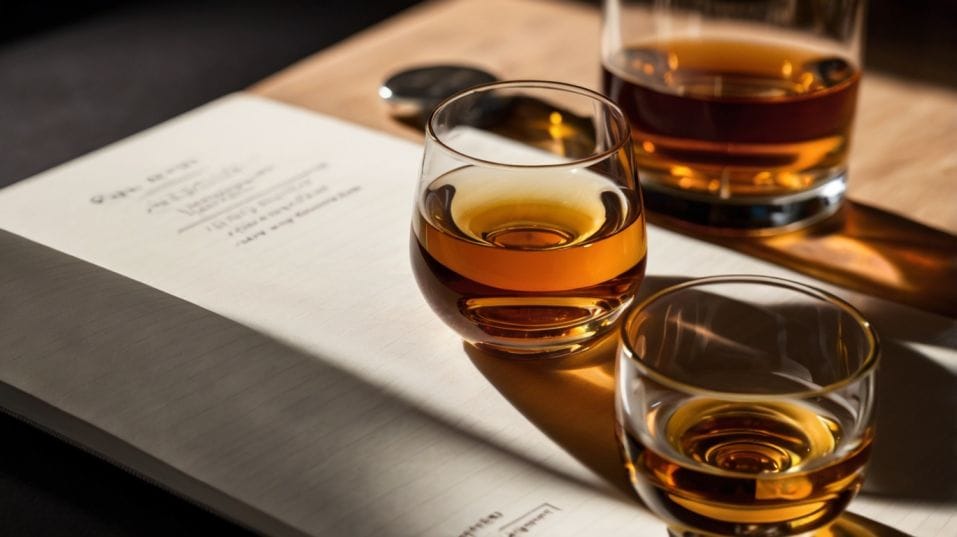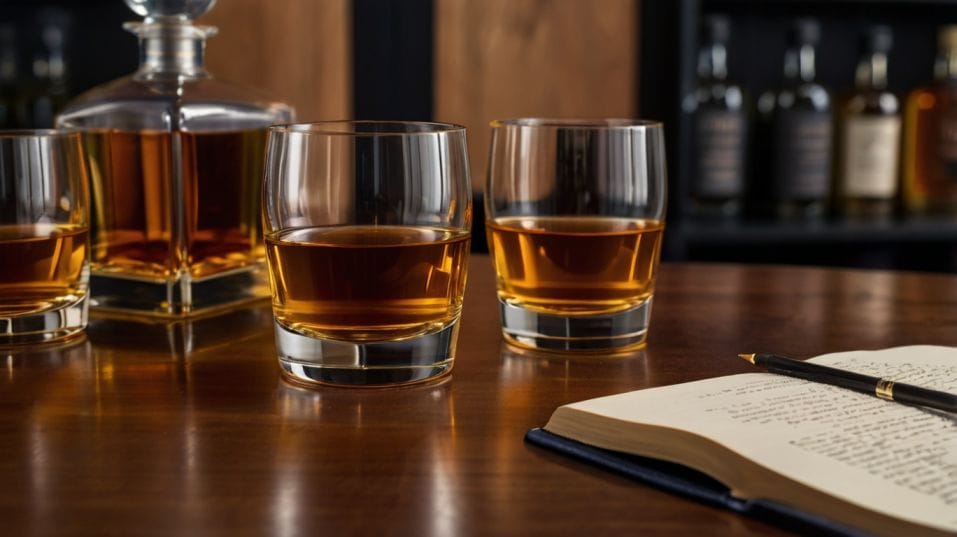How to Train Your Palate in 4 Weeks
Train your whiskey palate in 4 weeks. Learn to taste with confidence, build your flavor memory, and enjoy every pour with purpose.

Ever sip a whiskey and wonder what you're supposed to be tasting? You’re not alone. For many, early whiskey pours blur into heat and haze. But here’s the good news—great tasting isn’t a gift. It’s a skill.
And with just four weeks of focused practice, you can train your palate to pick up real nuance, build confidence with every pour, and enjoy whiskey on a whole new level. Ready to taste with purpose?
Week One: Cut the Noise and Tune In
Before you can start identifying flavors, you need to strip away everything that gets in the way.
Most people jump straight into tasting without preparing the space or their senses—and that’s why they hit a wall. Start by controlling your environment so your palate can finally do its job.
Create a Clean Tasting Environment
Before you can taste better, you need to feel what tasting actually is. That starts with eliminating interference.
Let’s get practical. Start tasting in the same place, at the same time of day, with minimal sensory clutter.
Sounds basic, but your brain is overloaded most of the time—blasting music, stale air, random snacks.
All that background noise dulls your perception. Choose a quiet space. No food, no candles, no distractions. Your palate is your tool now. Treat it that way.
Watch your intake outside the session, too. Overly spicy meals, strong coffee, toothpaste with whitening agents—these can all short-circuit your ability to pick up subtle flavors.
For best results, give yourself 30–60 minutes with water and a clean mouth before you pour anything.

Shift Your Mindset
Once the setup’s right, start rethinking your mindset. Don’t jump into a pour trying to “find the vanilla” or match someone else’s tasting notes.
That’s not tasting. That’s parroting. Instead, take a breath, smell the glass, and let your impressions come to you. Whatever you’re picking up—floral, earthy, sour, dry—is valid.
Don’t worry about being wrong. The only mistake is rushing past what your senses are actually telling you.
This week is about clarity. You’re not just tasting whiskey. You’re building a sensory baseline. Strip it back. Get quiet. Pay attention.
Week Two: Get Intimate with the Glass
Now that your environment’s clean and your attention’s dialed in, it’s time to go deeper. This week is all about pacing. Most beginners rush. Don’t. The slower you move, the more you notice—and that’s where real progress starts.
Go Slower Than You Think You Should
Now that you’ve muted the static, it’s time to dig in. Tasting well means slowing down—more than you think.
First up: aroma. Pour one ounce into a tulip-shaped glass. Let it sit for a few minutes. Then nose it gently. Don’t jam your face into the glass.
Hover, and breathe in with your mouth slightly open. Swirl once or twice if needed, but don’t overdo it. The goal isn’t to unlock hidden treasure. It’s to observe what’s already escaping.
Now sip—small, slow, and deliberate. Hold the whiskey in your mouth. Let it coat your tongue. Move it from front to back. Try to notice where the sensations hit.
Some spirits light up the sides of your tongue. Others leave heat at the back of the throat. Some feel soft and sweet up front, then snap bitter mid-palate.
Learn the Structure of Whiskey
This is texture work. Whiskey isn’t just a list of flavors—it’s a structure. Grain types, distillation cuts, barrel aging—these all leave tactile signatures.
Pay attention to how thick, sharp, oily, or dry the pour feels. You’re building your ability to detect contrast, and contrast is what makes tasting rewarding.
If you need a framework, try this sequence:
- First impression (nose and first sip): What jumps out? Bright? Rich? Muted?
- Mid-palate (hold and swirl): What evolves as it moves? Any heat spikes? Any fade?
- Finish (swallow and breathe out): Does the flavor linger? Shift? Does anything new appear?
You don’t need to write anything yet. Just notice. Taste once a day, two if you’re focused. Don’t chase volume—chase precision.
Week Three: Learn Through Contrast
You’ve built awareness. You’ve developed control. Now it’s time to stretch your palate in both directions.
This week, you’ll stop tasting in isolation and start learning through side-by-side comparison—because contrast teaches faster than repetition.
Comparison Is Your Best Teacher
Now that you’re tuned in and moving with intention, it’s time to introduce your most powerful teacher: comparison.
Side-by-side tasting is where your palate goes from curious to calibrated. This week, set up basic contrasts using bottles you already have—or sample pours if you’re buying small.
The trick isn’t what you taste. It’s how different they are from each other. Here are a few powerful matchups to start with:
- High-rye bourbon vs. wheated bourbon Notice how spice, heat, and sweetness play off each other.
- Peated Scotch vs. unpeated Highland Focus on the difference in nose intensity and smoke texture.
- Young whiskey vs. aged Watch how oak and oxidation change not just flavor, but mouthfeel and finish.
Build Recognition, Not Memory
Taste back and forth. Rinse with water. Take breaks. Then go back in reverse order.
Subtle notes will start to pop—maybe a citrus hit you missed before, or a dry wood tannin that now feels obvious. That’s the power of context: it makes hidden flavors visible.
Don’t aim to memorize. Aim to recognize. The more contrasts you experience, the better your sensory vocabulary gets. This also rewires how you approach collecting.
Instead of buying bottles for hype, you’ll start thinking in terms of flavor gaps and style balance. That’s a real collector’s mindset.
Week Four: Build Your Flavor Memory
You’ve tuned in, slowed down, and learned to compare. Now it’s time to lock that progress into your long-term memory. This week isn’t just about tasting—it’s about capturing what you’ve learned so it stays with you bottle after bottle.
Document What Matters
Now comes the real shift—from reaction to recognition. Your palate is sharper, your sessions more focused, your comparisons more meaningful.
This week, start documenting your experiences in a way that builds recall. Forget Instagram-friendly tasting notes. Build something for yourself.
Set up a simple system: one page per pour. Write down the date, the whiskey, and then divide your notes into nose, palate, and finish. Don’t write poetry. Write for clarity.
Example:
- Nose: toasted grain, dried cherry, vanilla cream
- Palate: oily, medium heat, cinnamon bark, nutmeg, orange peel
- Finish: long, dry oak, black tea, slight tobacco
Create Your Personal Flavor Map
Circle or underline anything that stands out. After a few sessions, you’ll start spotting patterns. Maybe you’re drawn to high-proof bottles that still feel balanced.
Maybe you’re discovering a soft spot for oloroso finishes. Maybe there’s a note you keep describing differently—proof you’re chasing it down with more precision each time.
This process turns flavor into memory. Next time you try a new bottle, your brain will reach for past patterns—and you’ll catch similarities faster.
Over time, that translates to instinct. You’ll walk into a whiskey bar or scroll through a bottle list and know what to try next, not just guess.
Final Thoughts
This isn’t magic. It’s process. Four weeks of purposeful tasting is all it takes to level up—no hype, no gimmicks, just sharp attention and repeatable habits.
Strip down the noise. Taste slow. Use contrast. Track what you find. Keep showing up. Your palate doesn’t need to be perfect. It just needs to be trained.
So tonight, grab two whiskeys. Pour half an ounce of each. Taste them side-by-side. Take your time. Write it down. You just started building your palate for real.




